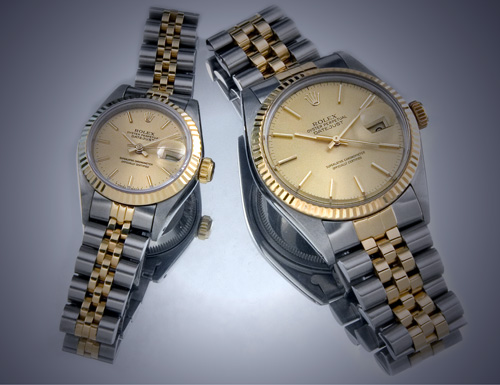An Adventure in Vintage Rolex:
My 1984 Rolex Datejust 16013
By: John B. Holbrook, II
April 27, 2006
Copyright 2006 - All Rights Reserved
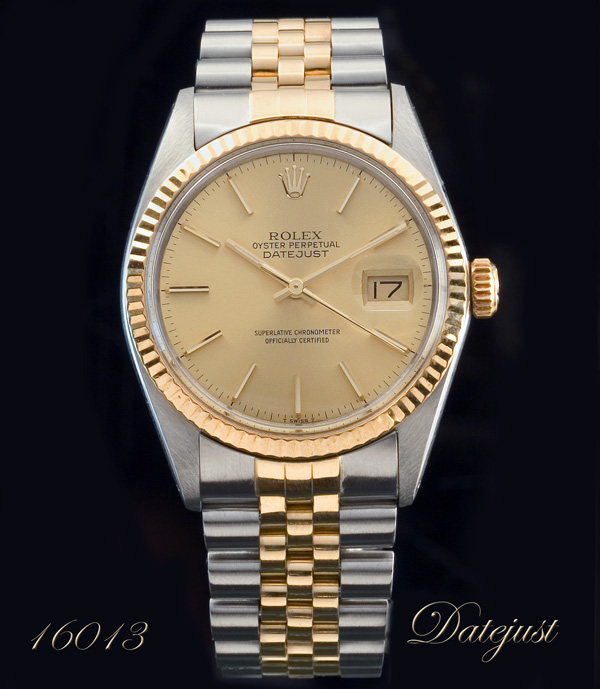
This story begins not with the purchase of my 1984 Rolex Datejust model 16013, but rather with the purchase of my wife's 69173 Datejust as a wedding gift (we were married just a few months ago on 1/28/06). She absolutely loves the watch, and I love to see her wearing it. She still has a lovely mother of pearl Wittnauer watch which she also loves...but now only sees about once a week wear, if that. Go Rolex!
Now, my wonderful bride has some definite opinions about my watches...from my Yacht-Master, which she really likes, to my Daytona which she thinks is "too busy." But since getting her Datejust, she's been wanting me to find a matching men's model. My recent birthday in April proved to be an excellent excuse... errrr... opportunity to please my wife and add another watch to my collection. Husbands out there...are you taking notes here?
Admittedly, I have far more experience with contemporary Rolex models than I do vintage. Ironically however, my very first Rolex was a 1970 Oyster Precision. While I no longer have the watch, I did gain an appreciation for how timeless the Rolex design is, and how well constructed their watches are... that vintage OP performed flawlessly. So when I spotted a smokin' hot deal on a 1984 16013 from a trusted dealer in Singapore, I immediately contacted him and a wire transfer of funds shortly followed (this same fellow sold me my previously mentioned Oyster Precision). It took a bit over a week to arrive from Singapore, but it was well worth the wait. Here's a photo of the watch sitting in the old style Datejust box:
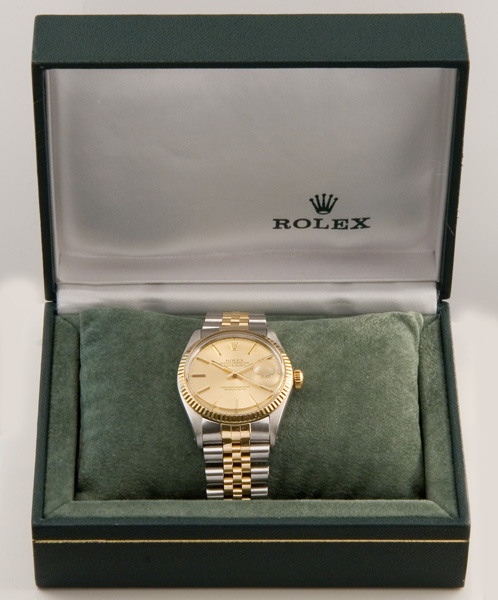
Here's a photo of the watch with the old booklets that came with Datejust models of this vintage:
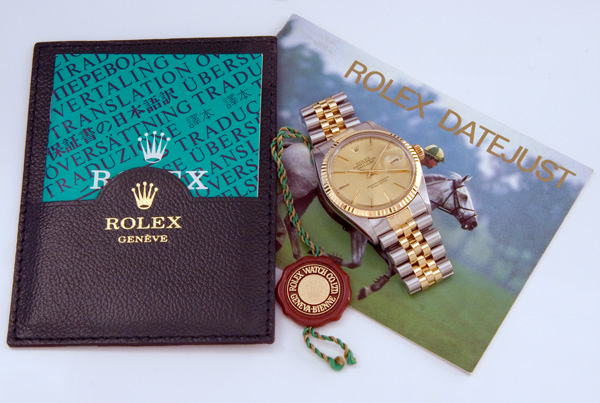
For those who don't know, Rolex basically has two categories of their watches. The Oyster Professional lines (Submariner, Sea-Dweller, GMT Master II, etc.) and the Oyster Perpetual line (the Datejust, Day-Date, etc.). People often write and ask me why there's so much information out there on Submariners, Daytonas, and GMT Masters, but very little written about the Datejust and Day-Date models. Historically, the Oyster Professional watches were purchased by a younger, more active demographic, while the Datejust and Day-Date models are more associated with an older demographic. Since it's that younger generation that's most active on the Internet, you see much more written about the Oyster Professional watches, than the Oyster Perpetual models. But don't let what you read on the Internet skew your perception of reality. Most experts agree that it's the Datejust, and not the much celebrated-on-the-web Submariner, which is Rolex's best selling model.
The Datejust was first introduced back in 1945, and the design was updated in the 1970's and has changed very little since. Here's a photo of my 16103 Datejust (right) next to this new 116138 Datejust. As you can see there's remarkably little difference in the two:

One of the first things I did when receiving my watch was to verify that the watch was not a fake. I think this is an important step for anyone who purchases a pre-owned Rolex - even from a trusted source like I did. Why? A seller can unwittingly pass along a fake watch if the seller was themselves duped when they acquired the watch. Now, I'm not an expert in spotting fakes by any stretch of the imagination. But, I'll share the techniques I use to determine authenticity on a watch. One of the first ways is to remove the bracelet of the watch, and examine the serial number. Here in this first photo, I've removed the bracelet from the 12 o'clock side of the watch, and you can see the engraving identifying it as an authentic Rolex product, and the model number:
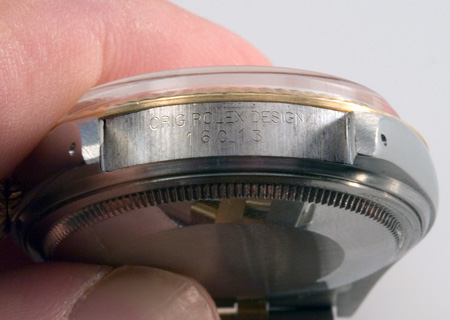
Now here's a shot with the bracelet removed from the 6 o'clock side of the watch head showing the actual serial number engraved on every Rolex watch. My friend Hannes who runs the web site www.oysterworld.de has a handy serial number reference which can help in determining the age of a watch:
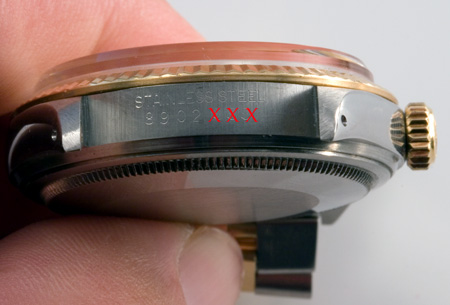
Now, I've digitally obscured part of the serial number (wouldn't want those nasty counterfeiters to have a legitimate serial number now would we?) but you can see my watch's serial is an 89xxxxx number which places it's production around 1984. Now, most contemporary Rolex models have a letter preceding the serial number - that practice didn't start until 1987. Now in most cases, most fakes won't have a serial number engraved in the lugs - some of the better fakes do, but the process they use looks different than a real engraving so those are fairly easy to spot. At this point, I was more than satisfied that my watch wasn't fake, but there's a second step I normally take which is ever more certain to help determine if a watch is an authentic Rolex timepiece - examining the movement. Now, this step is more difficult, and requires one to purchase some special tools (readily available from most watch tool suppliers) to remove the case back. If you're a novice, I don't recommend your attempting this step - better to take a watch to a qualified watch technician and have them remove the case back. Either way you go about it, by removing the case back and examining the movement, one can easily discern if the movement is in fact a genuine Rolex movement. Here's a couple of photos of the Rolex caliber 3035 in my Datejust:
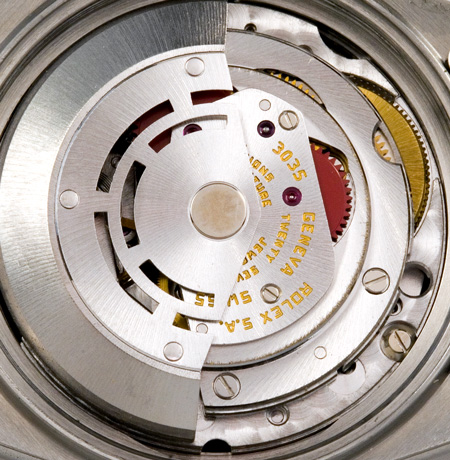
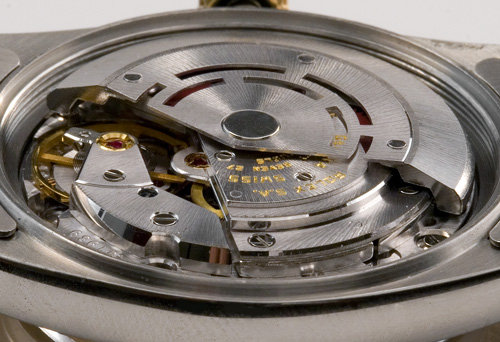
Many Rolex fakes will have quartz movements, so those are easy to spot by the lack of a sweeping second hand on the watch dial (a quartz watch has distinct "ticks" while a watch with a mechanical movement "sweeps"). But some better fakes use actual mechanical movements. Of those, some use cheap Japanese movements which don't have the same beat speed as a Rolex. Most modern Rolex movements are "high beat" movements with a beat speed of 28,800 beats per hour (BPH). The Japanese movements used in many fakes have a lower beat speed (between 17000 and 21000 BPH, which translates into a second hand sweep which isn't as smooth as what would be found with a watch containing a genuine Rolex movements. However, some higher end fakes use movements produced by the Swiss movement manufacturer ETA which have a beat speed which is the same as most modern Rolex movements - 28,800 BPH. However once the watch is opened and the movement is revealed, it's a simple matter to identify a true Rolex caliber. Notice the red anodized reverser gear in the first movement photo. It's very unique to Rolex and I know of no non-Rolex caliber that has this feature. The slotted pattern on the rotor of the self-winding mechanism is also a unique Rolex tradition. And while most Rolex movements are not finely finished to the level of Patek or Vacheron, there is finishing and decoration present that would not be in a fake movement. Note the rhodium plated "oeil-de-perdrix" decoration visible in the second photo - very distinctive. The Rolex 3035 was used by Rolex from about 1977 until 1988 when it was replaced by the currently in service Rolex 3135. The 27 jewel Rolex 3035 is a self-winding, mechanical movement, and features Microstella adjusting screws and a freely sprung Breguet balance spring - features which carried over to the 3135. Even after 22 years of service, the chronometer grade caliber 3035 in my Rolex Datejust keeps excellent time - +3 per day, which is well within COSC specifications.
I'm quite amazed at what great shape this vintage timepiece is in. Clearly it's been well cared for, both inside and out. Take a look at how clean the bracelet and clasp look from the backside:

This is my first experience with a Rolex "jubilee" bracelet. The Rolex Oyster style bracelet is my favorite, but I'm surprised at how much I like the jubilee on my Datejust - it's light, and very form fitting. As great a shape as this watch is in, the bracelet does exhibit what is known as "bracelet stretch." Basically, the hollow center links of this bracelet begin to elongate and "stretch out" over time. Gold jubilee bracelets seem to be particularly susceptible to this phenomenon. Perhaps the stretch in my bracelet isn't severe because it doesn't really seem to be all that noticeable when I wear it, but perhaps some day I'll look into replacing it.
Another neat "vintage" feature of my 1984 Datejust is the domed acrylic crystal over the dial. Some vintage purists swear they much prefer an acrylic crystal to a sapphire one, because an acrylic (plastic) crystal is more shatter resistant that sapphire, and the scratches it picks up are easily buffed out. It's a bit early in the game for me to weigh in on the issue, but I do like how the crystal looks on my Datejust - it give the watch a cool vintage "vibe" which makes me feel all retro and hip. Here's a shot of my Datejust (in front) with my 16613 Submariner in back. Note how thinly raised the sapphire crystal is on the Submariner vs. the domed acrylic crystal on the Datejust:
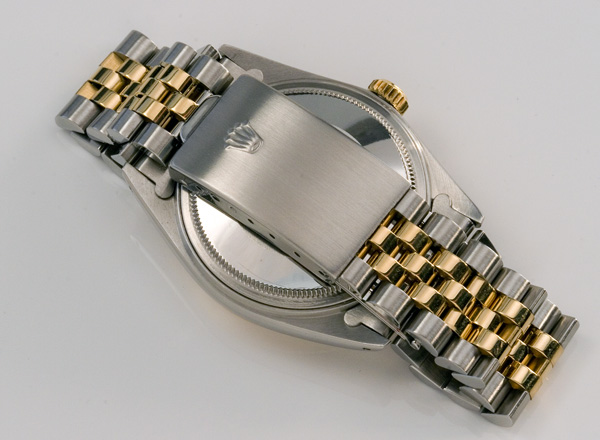
In the shot above you also get a bit of a close up view of the fluted bezel on my Datejust. The Datejust can be had with a smooth bezel as well, which looks nice, but the fluted bezel really sparkles in the light - quite the attention grabber.
My wife has made it very clear that my Datejust is the watch she likes most on me out of any in my collection. I'm sure she has sentimental reasons for liking it, but she also seems to think it looks more proportionate on my wrist. With a diameter of 36mm (not including the crown) the Datejust is considerable smaller than my other Rolex sport models which all measure in at roughly 40mm in diameter. Quite honestly, the size issue was one that held me back from getting the Datejust for a long time. But the size of the Datejust really is more appropriate as a dress watch. Purists will tell you not to wear a sport watch with a suit - of course I do it all the time. Here's a wrist shot of the Datejust on my roughly 7" wrist, and I have to admit it looks very dressy with a suit:
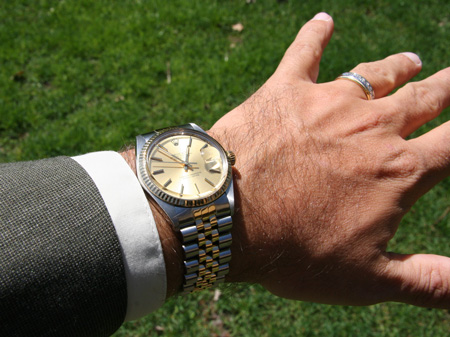
It's really fun having a vintage piece in my collection, and the fact that the watch matches my wife's makes it all the more special. I anticipate wearing it ocassionally through the week as a dress watch, and on our "date nights" through the week. The two-tone quality of the watch, along with the gold dial really make it a classy, dressy piece that I'll treasure for years to come. Pre-owned Rolex Datejusts and Day-Dates are some of the best values (in terms purchase price compared to retail price) on the secondary Rolex market. I highly recommend you pick one up!
